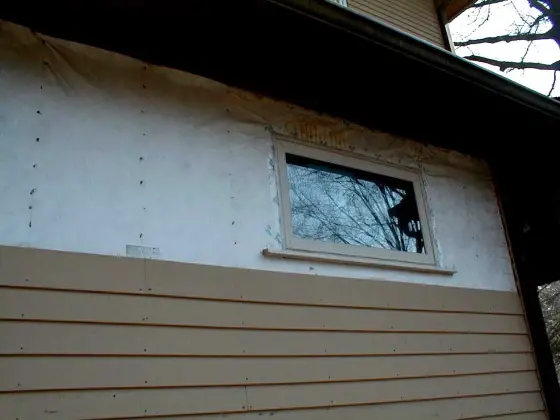Air and Water Infiltration Barriers

This is housewrap on my own home. I did some remodeling of my own and had to remove wood siding to install two small windows. The wrap was in perfect condition and I simply put back on the siding I removed.
DEAR TIM: I have heard about a widespread problem concerning houses that are rotting out because of water that gets behind the exterior stucco finish. Can this happen with other building materials like brick, stone, and the many different sidings? Doesn't the building code address rot concerns? How can you prevent wood rot in wood framing? Is it expensive? Robin B., Montgomery, OH
DEAR ROBIN: The rot problem you are referring to is real. It involves a synthetic stucco material called barrier Exterior Foam Insulating System (EIFS). In many, many instances, this exterior system was applied directly to the wood sheathing of houses. Water that infiltrated behind the synthetic stucco system got trapped against the wood sheathing and caused the wood to rot. Wood rot can happen in any house, but the barrier EIFS has a tendency to dramatically accelerate the rot process.
Many builders, remodelers, and homeowners forget that exterior finish materials such as brick, stone, cement stucco, vinyl siding, wood siding, etc. are the primary moisture barrier. They stop a majority of the water from wind driven rain, water balloon fights, and lawn sprinklers, but not always all of it. Water can leak through brick mortar. It can leak around the caulked edges of windows and doors. When this happens and there is no water barrier behind the exterior finish material, problems can begin.
Lumber used for wall studs and floor joists and plywood and oriented strand board (OSB) used for wall, floor and roof sheathing can resist a certain amount of wet/dry cycles. This is why the lumber doesn't rot during the construction process. It can readily dry. Drying times lengthen considerably when these materials are covered. The longer the wood stays damp or wet, the longer the fungi that cause wood rot can live. If you want to stop wood rot, you need to stop water from contacting wood sheathing and wood framing members.
The model building codes do address the issue of water membranes. But keep in mind that the model codes are a set of minimum standards. You can find tables in many of the codes that actually state that sheathing paper is not required behind aluminum, vinyl, and various wood sidings, but is required behind other exterior treatments. The code and I do not see eye to eye on this issue. Secondary protection from water can be achieved easily and inexpensively. I would always install a secondary water membrane of some type over wood sheathing and framing.
Many years ago, carpenters used ordinary asphalt saturated roofing felt paper to perform this job. I have taken apart 80 year old houses where the wood framing and sheathing were in perfect condition because the felt paper stopped water from contacting the wood. The asphalt felt paper was applied in horizontal strips starting at the bottom of the house and continuing up the structure overlapping several inches at each new course.
You can still use felt paper, but the modern air and water infiltration barriers might be better. Felt paper comes in 3 foot wide rolls. A one story house will require a minimum of 3 separate strips of felt that wrap around the entire house. The modern water and air barriers are available in rolls up to 10 feet wide requiring only a single pass on a one story home.
Protecting a house from water is cheap. An average sized single story house can be covered with a modern water and air infiltration barrier for approximately $325.00 for labor and material. Covering this same house with traditional felt actually costs more, $380.00, even though the material cost is less. The felt installation requires three wrapping trips around the house. These costs are a drop in the bucket compared to the cost to replace rotten wood sheathing or wood framing members if rot sets in. Make sure that your builder or remodeler uses some form of water membrane to cover the wood frame of your home or room addition before any finish materials are applied.
Column 311